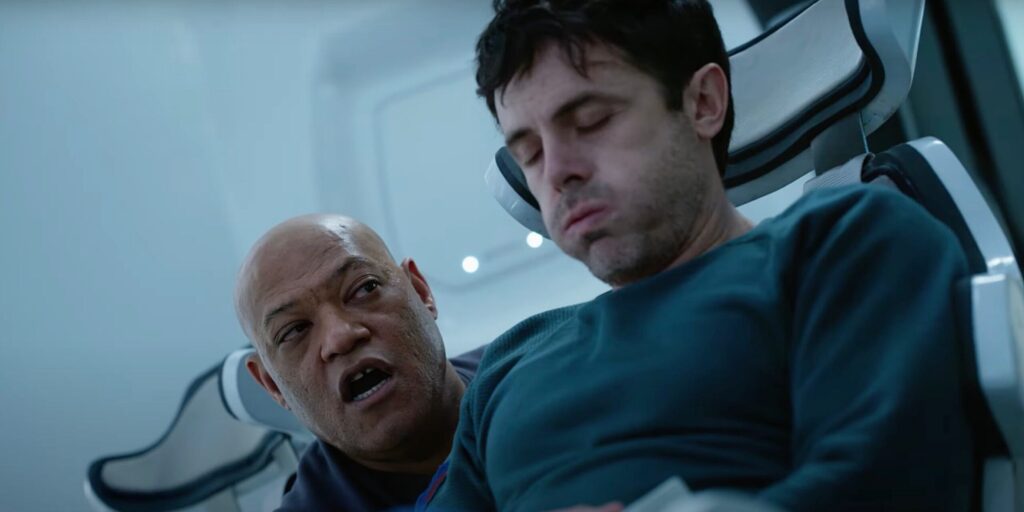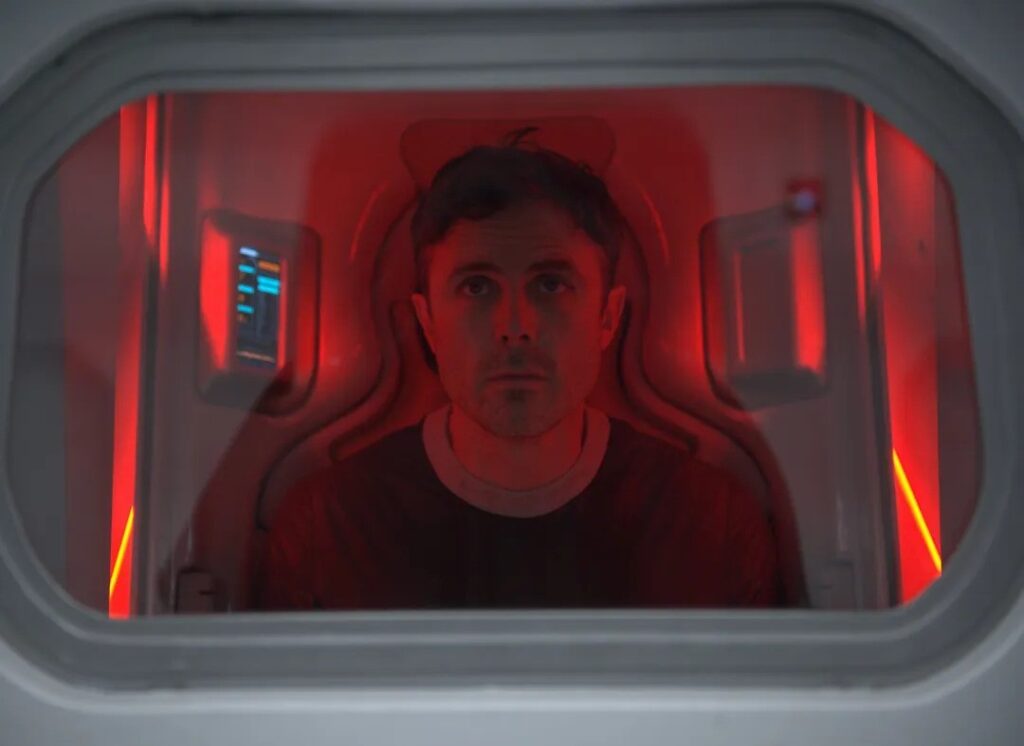Slingshot is a new science fiction thriller that follows three astronauts on a journey to Saturn’s largest moon, Titan. To get there, the crew must execute a flyby maneuver using Jupiter’s gravitational field, known as a slingshot, which also gives the film its title. Despite the premise, the film’s focus shifts away from astrophysics and centers on exploring the psychological effects of long-term space missions.

The plot
Released on August 30, 2023, Slingshot centers around three astronauts played by Casey Affleck, Laurence Fishburne, and Tomer Capone who are undertaking humanity’s first mission to Titan, the largest satellite in the Solar system.
Titan is very similar to ancient Earth and brims with organic matter. The journey would realistically take decades, not months, so a gravity assist from Jupiter is essential to shorten the trip. Even with such acceleration, the flight in Slingshot spans a grueling two years, requiring the crew to carefully ration their resources and spend most of the journey in hibernation, with only occasional waking cycles.
The film’s central narrative focuses on the adverse effects of hibernation drugs, gradually revealing the pathology through John (Casey Affleck) and his crew’s increasingly erratic behavior.

The situation deteriorates further when an unidentified object impacts the spacecraft, severing all communications with Earth. Despite all systems appearing operational, the crew faces a critical decision: continue with the mission or abort and return to Earth. This dilemma intensifies the conflict among them.
The main plot line is intercut with John’s memories of his relationship with Zoe (Emily Beecham), one of the flight controllers. As John’s mental state deteriorates, he begins to hallucinate that his girlfriend is aboard the ship, adding another layer of psychological tension.
The science
The film’s approach to scientific accuracy is a rather mixed bag. On the one hand, you have artificial gravity that exists on the ship seemingly out of nowhere — the spacecraft has no apparent rotational sections to generate it.

On the other hand, the mission’s concept and everything you learn about Titan are spot on. This moon is undoubtedly one of the most fascinating objects in the Solar system, and future expeditions for its exploration will almost certainly happen. Overall, the film accurately addresses the logistics of such a long journey, staying true to our current knowledge of the subject.
Titan’s mother planet, Saturn, is approximately 886 million miles away from Earth at its closest approach. Meanwhile, the ship depicted in the film is, to put it plainly, enormous. This brings up a significant challenge: how do you generate enough speed to propel such a massive structure, along with its crew, while ensuring the ship can effectively slow down at the right moment?
Enter the titular slingshot. Orbital mechanics are so complex that traveling between two planets in a straight line is virtually impossible given current speed limitations. The solution lies in achieving far greater acceleration—reaching speeds of thousands of miles per second—something that remains a distant dream in real-world physics and, it seems, for the characters in Slingshot as well.

In the film, with the speeds they can achieve, it would take decades to reach Saturn on a curved trajectory, burning massive amounts of fuel along the way. To mitigate this, their plan is to use a gravity assist from Jupiter. By passing through its gravitational field and igniting the engine at precisely the right moment, they can gain a significant speed boost.
This maneuver allows them to cover thousands of miles in the right direction without expending excessive fuel. However, once they reach Saturn, they will still need to burn a considerable amount of fuel to slow down, but that’s a problem for the future.
Overall, the film does a good job portraying the physics of space travel, with one major exception: the highly unrealistic plan for the return journey. The crew only carries enough fuel for a one-way trip, relying on the idea of mining resources on Titan to refuel for the return—a strategy that seems quite far-fetched. No space agency would approve a mission that risks the crew’s safety to such an extent without first sending research probes to conduct thorough checks.
Then there’s the concept of hibernation. The current scientific consensus suggests that it’s highly improbable for human hibernation to ever become a reality. While it’s a convenient sci-fi trope, especially for rationing resources on long space journeys, the closest real-world equivalent is a medically induced coma. However, this procedure carries significant risks and is only used in extreme cases to stabilize critically ill patients.
Psychological effects of space travel
That said, Slingshot is less focused on perfect scientific accuracy and more interested in exploring the psychological effects of space travel, particularly how prolonged isolation can impact human behavior and mental well-being.
This is the film’s thematic crux, where ambiguity becomes both challenging and compelling. After the ship sustains unexpected damage and loses communication with flight control, the crew seems oddly fixated on the source of the impact rather than the more pressing issue of being cut off. Strangely, no one proposes to investigate the root cause of the incident or to conduct a manual systems’ diagnosis, or to even consider turning back. Instead, the decision is left to the captain, who orders the mission to proceed without further deliberation.
Judging by the characters’ responses to the crisis, it’s evident that none of them would realistically pass astronaut selection. The film emphasizes this by highlighting how their erratic behavior is, in part, a consequence of hibernation, which has impaired their memory, perception, and emotional stability.
Soon, it becomes clear that all three crew members are suffering from the same side effects, turning what starts as a straightforward premise into a psychological exploration of three mentally unstable men trapped in isolation. Though entertaining, the theater of it all never fully convinces. After all, no professional crew would be permitted to take experimental drugs without thorough clinical trials beforehand.

Just as the plot veers into schlock, a final twist reveals that John has been alone all along. The captain and Nash, his supposed crewmates, are actually his split personalities. In reality, John never went to space—everything we’ve seen is part of a trial on Earth being conducted underground. His hallucinations are the result of an overdose of the experimental drug, and the communications blackout was actually caused by an earthquake.
It remains unclear which elements are real and which are hallucinations. It’s entirely possible that the entire twist is a fabrication of John’s mind, an attempt to rationalize his experiences. The film never provides a definitive answer, leaving the truth ambiguous and open to interpretation.
Slingshot is firmly committed to its ambiguity. Its efforts to blur the lines between reality and illusion are as unsubtle as they are effective. Overall, the story is geared more towards the fans of psychological thrillers. If you’re looking for a traditional space adventure, this might not be your cup of tea. But as a piece of mind-bending drama, it’s definitely worth checking out.


